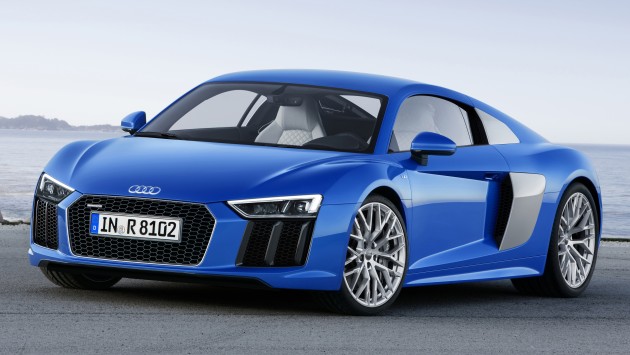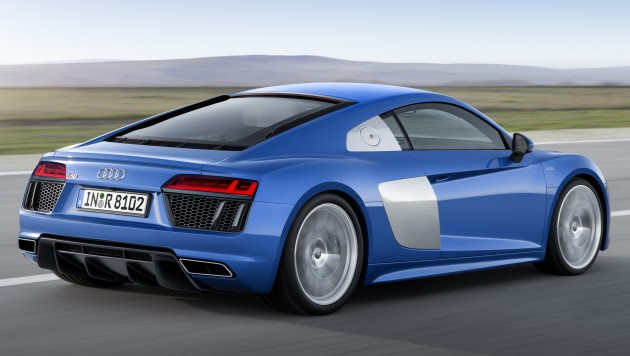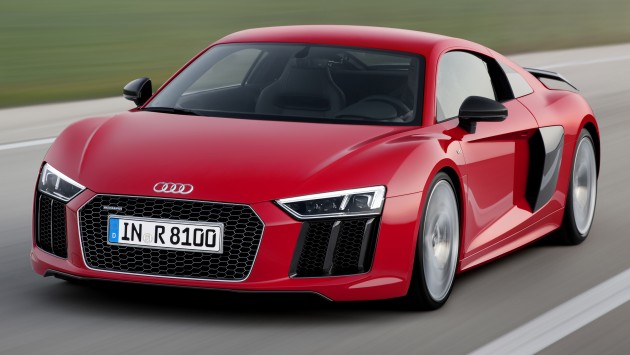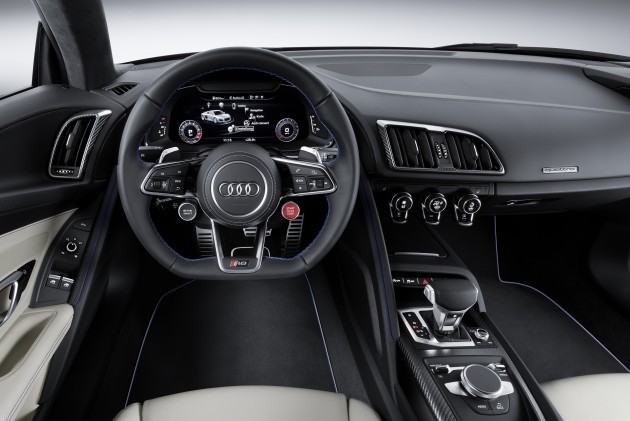
This is it, boys and girls, the new 2016 Audi R8. Spied, teased and leaked multiple times, we've finally got the lowdown on Ingolstadt's poster boy supercar ahead of its world premiere at the 2015 Geneva Motor Show next week. It will go on sale starting this summer, with prices ranging from €165,000 (RM673,700) for the standard model to €187,400 (RM765,200) for the top-of-the-range plus.
Looks very...familiar, doesn't it? Measuring 4.42 metres long and 1.24 metres high, and with a 2.65 metre wheelbase, the dimensions of the new R8 has changed only slightly from the old car, with the exception of being around four centimetres wider at 1.94 metres wide.
The styling cues are evolutionary rather than revolutionary, too. The six-point single-frame front grille stays on but is flatter, flanked by trapezoidal headlights (LED units as standard, laser-powered ones optional) and large air intakes. The characteristic "side blades" have also been split into two to make the car seem longer and more dynamic.

The rear is more angular than before, with trapezoidal exhaust outlets replacing the round pipes on the facelifted original. The standard car gets an extendable rear spoiler, with the plus model getting a fixed carbon fibre unit. As standard, the new R8 is fitted with 19-inch wheels; 20-inch rollers are available as an option for the first time.
The cockpit-like driver-oriented interior will be familiar to those who own the current R8, but there's a new configurable 12.3-inch Audi virtual cockpit display in the instrument binnacle from the new TT that replaces the old centrally-mounted MMI display. The standard sports seats have also been redesigned, and there's are new optional bucket seats that come as standard on the plus.
Both the start button and the rotary dial to select the four modes (comfort, auto, dynamic and individual) on the Audi drive select system are mounted on the steering wheel. In addition, there's also an optional performance mode (again standard on the plus) that has specific driving programs for dry, wet and snowy conditions.

Gone is the base 4.2 litre V8 on the previous car – from now on the R8 will be V10-only, the same 5.2 litre direct-injected unit as before but with added indirect injection for improved performance and fuel economy. Two variants will be available – the standard car produces 540 hp and 540 Nm, gets from 0-100 km/h in 3.5 seconds, has a top speed of 323 km/h, uses 11.8 litres of fuel per 100 km and emits 275 grams of carbon dioxide per kilometre.
Moving up, the uprated plus model punches out 610 hp and 560 Nm, propelling it from zero to 100 km/h in 3.2 seconds and 200 km/h in 9.9 seconds before reaching a top speed of 330 km/h. Fuel consumption and CO2 emissions figures are 12.4 litres per 100 km and 285 grams per kilometre respectively.
The new R8 uses up to 10% less fuel than before, thanks to a start-stop system and a coasting function for the standard-fit S tronic transmission. Yes, that's right – sorry guys, there's no more six-speed open-gate manual gearbox for you to enjoy; the only way the car rows its gears is through a seven-speed dual-clutch transmission, with shift-by-wire, three shift modes and launch control.

As before, quattro permanent all-wheel drive is fitted on all models, with a hydraulic multi-plate clutch replacing the viscous clutch on the previous R8. The system can now send up to 100% of torque to either axle, and a rear mechanical limited-slip differential ensures maximum traction.
Under the skin is a new multi-material Audi Space Frame (ASF) that uses copious amounts of aluminium and carbon fibre. Despite torsional rigidity being 40% higher than before, the bodyshell is 15% lighter, resulting in a dry weight of just 1,454 kg.
Aluminium double wishbone suspension is fitted all-round, while electromechanical power steering replaces the previous hydraulic unit; Audi magnetic ride dampers and variable-ratio dynamic steering are available as an option. As on the RS6, the R8 features lightweight wavy steel brake discs as standard, with carbon ceramic discs being optional (and fitted as standard on the plus).




No comments:
Post a Comment